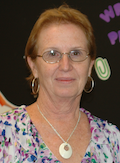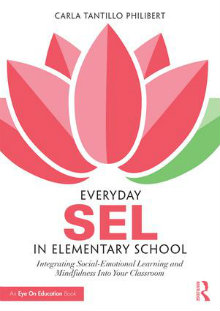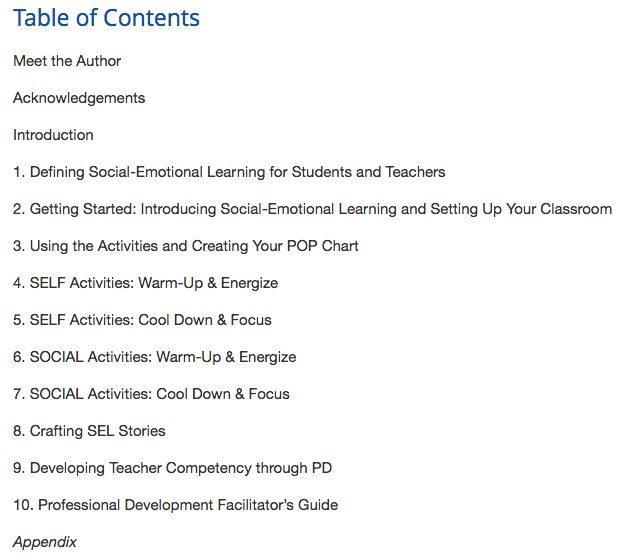Integrating SEL and Mindfulness into Class
Everyday SEL in Elementary School: Integrating Social-Emotional Learning and Mindfulness Into Your Classroom
By Carla Tantillo Philibert
(Routledge/Eye On Education, 2017 – Learn more)

Carla Tantillo Philibert’s magnificent new book, Everyday SEL in Elementary School: Integrating Social-Emotional Learning and Mindfulness Into Your Classroom, addresses the social and emotional learning of our students and gives inspiring, practical advice and lessons to meet their social and emotional needs.

I am also a teacher who knows how much time it takes to write a lesson, differentiate to meet my students’ academic potential, and assess my students. I know about all the new buzz words that teachers are expected to learn and apply in their classrooms. I know the feeling that many educators feel… “If my district expects me to apply one more buzz word or initiative into my classroom, then…”
Tantillo Philibert also knows how teachers feel. She is an advocate for our children and teachers. She knows that teaching is one of the most demanding jobs but is also the most rewarding.
In her book she addresses how teachers can take a step back, reflect on their teaching, and establish a mindfulness environment in their classroom. She also knows that sometimes teaching may seem isolated. The great thing about her book is that she not only explains the why and how to infuse mindfulness into your classroom, but also how to create a culture of mindfulness in your school and potentially in your district.
The concept of Mindfulness Practice
There are many books that have been written about mindfulness and many definitions as well. This book bases its Mindfulness Practice lessons on four key components and competencies:
- Self-Awareness
- Self-Regulation
- Social Awareness
- Balance Between Self-Efficacy and Social Harmony
What I find comforting in this approach is that the author acknowledges that before we can practice mindfulness, we need to address the needs of the WHOLE child. There is a “connection between a student’s health and wellness and their ability to be a present, focused, and collaborative member of the classroom community.” (p. 14)
The author also recognizes how critical it is create a culture within a school system that addresses mindfulness with consistency and intentionality. (p. 15) Take for example something that we may think of as very simplistic: code-switching of consequences or rules.
In one classroom students may be allowed to sharpen their pencils without raising their hands, yet with another teacher they need to raise their hands and ask for permission. This leads to confusion and possible classroom management problems.
When a school establishes a SEL culture with consistency, such as explained thoroughly in Tantillo Philibert’s book, more learning and fewer student discipline problems occur. The students need the stability and reliability of knowing what the rules and procedures are in all situations.
I admire Tantillo Philibert for her candidness, honesty and openness. She admits that,
Before diving into the Mindful Practices approach outlined in this book, it must be said that it is incomplete. For this work to have the greatest impact, we need to pair teachers with fields outside of education…with pediatricians, trauma therapists, nutritionists, cultural experts, physical therapists – people who can help us, as educators, better understand the body’s psychosomatic response to stress and how it impacts learning along with information that can make the material more culturally sensitive and responsive to the populations we are serving. (p. 4)
Inside the book
The book is organized by first defining what SEL (Social Emotional Learning) is, how to introduce SEL into your classroom, and how to use the activities and the POP (Pause, Own it, Practice) chart. Next, the two components of SEL – the self and the social – are explained with activities to use with the students.
There are a number of activities that you can lead your students through as you begin your journey toward a mindful environment – games, simple yoga activities, breathing techniques, talking sticks, goal setting.
The book also offers a Professional Development Facilitator’s Guide to help you and your colleagues understand the core components of SEL and Mindfulness and how to promote it schoolwide. The appendix gives strategies and answers questions that might occur during the beginning stages of implementing this approach in your school.
A super PD resource
Tantillo Philibert’s book is an important and helpful resource for all teachers, regardless of their experience level.
I could hardly contain my excitement when my assistant principal mentioned that she was going to provide professional development about mindfulness to colleagues the following week. I was that kid in the back of the room who keeps jumping up and down when he/she knows the answer. “You have to read this book. There are so many ideas in it that I don’t know where to begin. Would you like to borrow my book (with the pages full of sticky notes and highlights)?” Luckily, I had finished reading the book so I was able to let her borrow it – borrow, not keep!
For those teachers who already practice mindfulness in their classrooms, I applaud you for sharing this great gift with your students. For those teachers who are ready to begin the journey, I applaud you and ask you to work together to create a culture of mindfulness.
And for teachers who may be reluctant to begin, just watch the changes that will occur in the classroom when you begin practicing mindfulness. I enjoyed reading this book from start to finish. You will wish you had started practicing mindfulness in your classroom much sooner.
Happy reading!
Linda Biondi is a fourth grade teacher at Sharon Elementary School in Robbinsville, NJ and a long-time Morning Meeting practitioner. She’s also the recipient of several educational grants, a Teacher Consultant with the National Writing Project, and a participant on the NJ Department of Education Teacher Advisory Panel and with ECET2 Celebrate Teaching.

































Linda, I’m just curious whether the author advocates getting parent permission for teaching something that if not made clear, the parents may think is too “touchy feely,” or some kind of indoctrination. We used to get permission to teach yoga, for example. If the author doesn’t, what do you think?